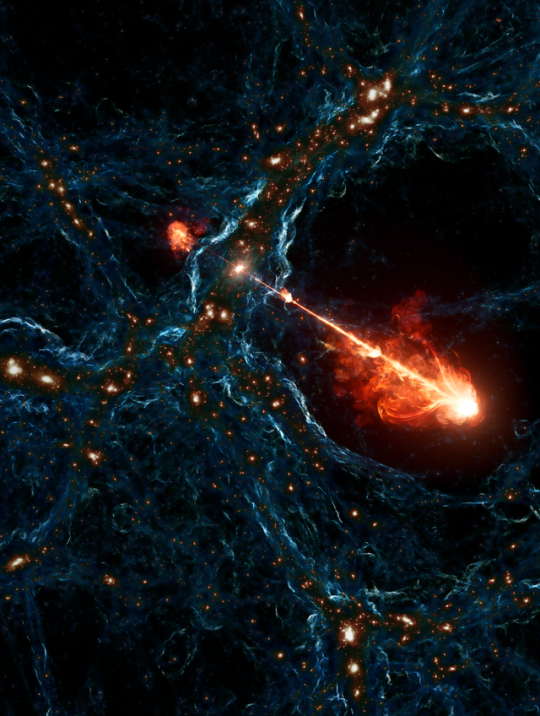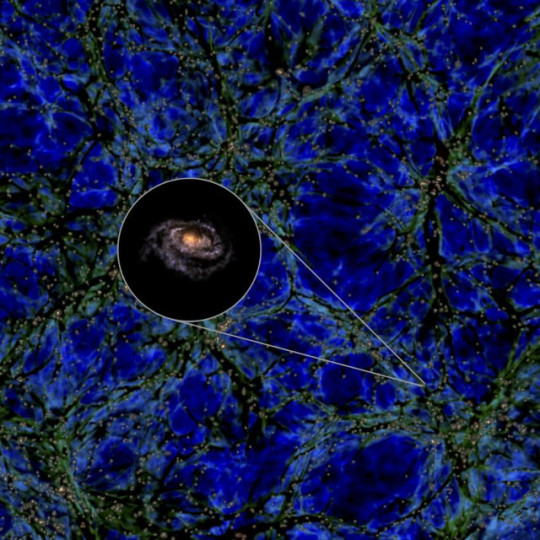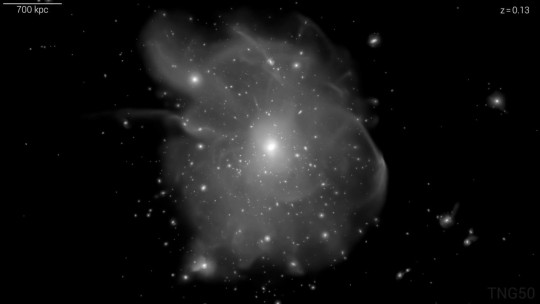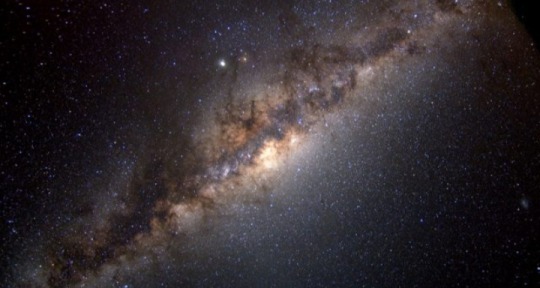#IllustrisTNG
Explore tagged Tumblr posts
Text

An artist's illustration of the longest black hole jet system ever observed. Nicknamed Porphyrion after a mythological Greek giant, these jets span roughly 7 megaparsecs, or 23 million light-years. That is equivalent to lining up 140 Milky Way galaxies back-to-back.
Porphyrion’s jets are estimated to contain the total power of trillions of suns and raise the temperature of surrounding gas by a million degrees Celsius. This means they may have inhibited the formation of not just stars but entire galaxies in the early universe. Their high-speed sprays of magnetized ejecta also could have pierced and filled voids in the cosmic web, the network of matter-rich filaments and matter-sparse cavities that forms the universe’s large-scale structure.
To better assess the impact such jets may have had on the early universe, researchers will need to create a more comprehensive catalog of the structures. The new study surveys just 15 percent of the sky, possibly leaving many more jets yet to be discovered.
E. Wernquist/D. Nelson (IllustrisTNG Collaboration)/M. Oei (CC BY-NC-ND)
#black hole#black hole jet#Porphyrion#23 million light years#7 megaparsecs#140 million Milky Way galaxies#science#astronomy#scientificamerican#physics#Low Frequency Array (LOFAR)#Giant Metrewave Radio Telescope in India#W. M. Keck Observatory in Hawaii#Martijn Oei#astronomer#California Institute of Technology#E. Wernquist#D. Nelson#M. Oei#IllustrisTNG#astrophysics
7 notes
·
View notes
Text

Porphyrion - record-breaking plasma jet streams, measuring about 23 million light years from end to end (140 times the length of our entire galaxy), ejected from a black hole in a galaxy 7.5 billion light years away. Their ejection began when the universe was half the age it is now; their discovery was announced today in an article in Nature Magazine, spotted by the Low-Frequency Array telescope network.
Universe has some incredible things in it.
Artist's illustration: E Wernquist/D Nelson/IllustrisTNG Collaboration/M Oei/Caltech/PA
16 notes
·
View notes
Text

An artist’s concept of Porphyrion, a jet of material 23 million light-years long that dates back to a time when the universe was less than half its present age. Credit...E. Wernquist/D. Nelson (IllustrisTNG Collaboration)/M. Oei
OUT THERE
This Black Hole Has a Cosmic Wingspan
Astronomers have discovered a black hole emitting energy in jets longer than the width of 140 Milky Way galaxies.
https://www.nytimes.com/2024/09/25/science/space/black-hole-m87-energy.html?unlocked_article_code=1.Nk4.WCTE.lqTrpWk9BULL&smid=nytcore-ios-share&referringSource=articleShare
4 notes
·
View notes
Text
Revisiting The Bimodality Of Galactic Habitability In IllustrisTNG
Revisiting The Bimodality Of Galactic Habitability In IllustrisTNG
0 notes
Link
0 notes
Text

An article published in the journal "Monthly Notices of the Royal Astronomical Society" reports the results of a study that indicates that the Milky Way is abnormally massive in relation to the so-called Local Sheet, the group of galaxies that surround it. A team of researchers used simulations conducted within the IllustrisTNG project and discovered that a galaxy in the same situation as the Milky Way should be much smaller than the cosmic wall that surrounds it. The simulations indicate that there's one exception for every million galaxies in IllustrisTNG under the same conditions. This must be kept in mind in studies of galactic environments.
0 notes
Text
Opgezwollen sterrenstelsel kunnen langer sterren vormen dan hechte compacte sterrenstelsels
Opgezwollen sterrenstelsel kunnen langer sterren vormen dan hechte compacte sterrenstelsels
Een verzameling van 25 schijf-sterrenstelsels. Links foto’s van de stelsels in H-alpha van interstellair gas, een graad meter voor de stervorming, rechts optisch licht van jonge (blauwe) en oude (rode) sterren. Credit: TNG Collaboration. Recent onderzoek laat zien dat ‘opgezwollen’ sterrenstelsels, formeel heten ze ‘extended galaxies’, langer stervorming in stand houden dan hechte, compacte…

View On WordPress
0 notes
Text
Opgezwollen sterrenstelsel kunnen langer sterren vormen dan hechte compacte sterrenstelsels
Opgezwollen sterrenstelsel kunnen langer sterren vormen dan hechte compacte sterrenstelsels
Een verzameling van 25 schijf-sterrenstelsels. Links foto’s van de stelsels in H-alpha van interstellair gas, een graad meter voor de stervorming, rechts optisch licht van jonge (blauwe) en oude (rode) sterren. Credit: TNG Collaboration. Recent onderzoek laat zien dat ‘opgezwollen’ sterrenstelsels, formeel heten ze ‘extended galaxies’, langer stervorming in stand houden dan hechte, compacte…

View On WordPress
0 notes
Photo

IllustrisTNG - Most perfect model of the universe
#Astronomy, #Astrophysics, #Black_Holes, #Cosmological, #Cosmology, #Cosmos, #Dark_Matter, #Evolution, #Formation, #Galaxies, #Galaxy_Formation, #Heidelberg, #Illustris, #Illustristng, #Illustristng_Collaboration, #Interstellar, #Light_Years, #Magnetic_Fields, #Physics, #Researcher, #Supermassive, #Tng_Collaboration, #Tng100, #Universe
#astronomy#astrophysics#black holes#cosmological#cosmology#cosmos#dark matter#evolution#formation#galaxies#galaxy formation#heidelberg#illustris#illustristng#illustristng collaboration#interstellar#light years#magnetic fields#physics#researcher#supermassive#tng collaboration#tng100#universe#Physics & Cosmos#Space & Time
0 notes
Video
youtube
From Astronomy Picture of the Day; February 19, 2018:
Galaxy Formation in a Magnetic Universe Video Credit: IllustrisTNG Project; Visualization: Mark Vogelsberger (MIT) et al.; Music: Gymnopedie 3 (Composer: Erik Satie, Musician: Wahneta Meixsell)
How did we get here? We know that we live on a planet orbiting a star orbiting a galaxy, but how did all of this form? To understand details better, astrophysicists upgraded the famous Illustris Simulation into IllustrisTNG -- now the most sophisticated computer model of how galaxies evolved in our universe. Specifically, this featured video tracks magnetic fields from the early universe (redshift 5) until today (redshift 0). Here blue represents relatively weak magnetic fields, while white depicts strong. These B fields are closely matched with galaxies and galaxy clusters. As the simulation begins, a virtual camera circles the virtual IllustrisTNG universe showing a young region -- 30-million light years across -- to be quite filamentary. Gravity causes galaxies to form and merge as the universe expands and evolves. At the end, the simulated IllustrisTNG universe is a good statistical match to our present real universe, although some interesting differences arise -- for example a discrepancy involving the power in radio waves emitted by rapidly moving charged particles.
#astronomy#astronomy picture of the day#galaxy#galaxy formation#galaxy evolution#simulation#Illustris Simulation#IllustrisTNG#magnestism#magnetic field#physics#astrophysics
3 notes
·
View notes
Photo

Simulation TNG50: A Galaxy Cluster Forms : How do clusters of galaxies form? Since our universe moves too slowly to watch, faster-moving computer simulations are created to help find out. A recent effort is TNG50 from IllustrisTNG, an upgrade of the famous Illustris Simulation. The first part of the featured video tracks cosmic gas (mostly hydrogen) as it evolves into galaxies and galaxy clusters from the early universe to today, with brighter colors marking faster moving gas. As the universe matures, gas falls into gravitational wells, galaxies forms, galaxies spin, galaxies collide and merge, all while black holes form in galaxy centers and expel surrounding gas at high speeds. The second half of the video switches to tracking stars, showing a galaxy cluster coming together complete with tidal tails and stellar streams. The outflow from black holes in TNG50 is surprisingly complex and details are being compared with our real universe. Studying how gas coalesced in the early universe helps humanity better understand how our Earth, Sun, and Solar System originally formed. via NASA
348 notes
·
View notes
Text
WHAT IS A COSMOLOGICAL WALL??
Blog#267
Wednesday, February 1st, 2023
Welcome back,

Is the Milky Way special, or, at least, is it in a special place in the Universe? An international team of astronomers has found that the answer to that question is yes, in a way not previously appreciated. A new study shows that the Milky Way is too big for its “cosmological wall,” something yet to be seen in other galaxies. The new research is published in Monthly Notices of the Royal Astronomical Society.
A cosmological wall is a flattened arrangement of galaxies found surrounding other galaxies, characterized by particularly empty regions called ‘voids’ on either side of it. These voids seem to squash the galaxies together into a pancake-like shape to make the flattened arrangement. This wall environment, in this case, called the Local Sheet, influences how The Milky Way and nearby galaxies rotate around their axes, in a more organized way than if we were in a random place in the Universe, without a wall.

Typically, galaxies tend to be significantly smaller than this so-called wall. The Milky Way is found to be surprisingly massive in comparison to its cosmological wall, a rare cosmic occurrence.
The new findings are based on a state-of-the-art computer simulation, part of the IllustrisTNG project. The team simulated a volume of the Universe nearly a billion light-years across that contains millions of galaxies. Only a handful – about a millionth of all the galaxies in the simulation – were as “special” as the Milky Way, i.e. both embedded in a cosmological wall like the Local Sheet, and as massive as our home galaxy.

According to the team, it may be necessary to take into account the special environment around the Milky Way when running simulations, to avoid a so-called “Copernican bias” in making scientific inference from the galaxies around us. This bias, describing the successive removal of our special status in the nearly 500 years since Copernicus demoted the Earth from being at the center of the cosmos, would come from assuming that we reside in a completely average place in the Universe.

To simulate observations, astronomers sometimes assume that any point in a simulation such as IllustrisTNG is as good as any, but the team’s findings indicate that it may be important to use precise locations to make such measurements.

So, the Milky Way is, in a way, special,” said research lead Miguel Aragón. “The Earth is very obviously special, the only home of life that we know. But it’s not the center of the Universe, or even the Solar System. And the Sun is just an ordinary star among billions in the Milky Way. Even our galaxy seemed to be just another spiral galaxy among billions of others in the observable Universe.”
“The Milky Way doesn’t have a particularly special mass, or type. There are lots of spiral galaxies that look roughly like it,” Joe Silk, another of the researchers, said. “But it is rare if you take into account its surroundings. If you could see the nearest dozen or so large galaxies easily in the sky, you would see that they all nearly lie on a ring, embedded in the Local Sheet."

"That’s a little bit special in itself. What we newly found is that other walls of galaxies in the Universe like the Local Sheet very seldom seem to have a galaxy inside them that’s as massive as the Milky Way.”
Originally published on scitechdaily.com
COMING UP!!
(Saturday, February 4th, 2023)
"WHAT ARE GLUONS"??
#astronomy#outer space#alternate universe#astrophysics#spacecraft#universe#white universe#space#parallel universe#astrophotography#cosmology#galaxies#milkway
91 notes
·
View notes
Video
youtube
2023 May 31
Simulation: A Disk Galaxy Forms Video Credit: TNG Collaboration, MPCDF, FAS Harvard U.; Music: World's Sunrise (YouTube: Jimena Contreras)
Explanation: How did we get here? We know that we live on a planet orbiting a star orbiting a galaxy, but how did all of this form? Since our universe moves too slowly to watch, faster-moving computer simulations are created to help find out. Specifically, this featured video from the IllustrisTNG collaboration tracks gas from the early universe (redshift 12) until today (redshift 0). As the simulation begins, ambient gas falls into and accumulates in a region of relatively high gravity. After a few billion years, a well-defined center materializes from a strange and fascinating cosmic dance. Gas blobs -- some representing small satellite galaxies -- continue to fall into and become absorbed by the rotating galaxy as the present epoch is reached and the video ends. For the Milky Way Galaxy, however, big mergers may not be over -- recent evidence indicates that our large spiral disk Galaxy will collide and coalesce with the slightly larger Andromeda spiral disk galaxy in the next few billion years.
∞ Source: apod.nasa.gov/apod/ap230531.html
46 notes
·
View notes
Text
Ученые создали копию Вселенной
Ученые опубликовали информации о создании ими самого реалистичного макета Вселенной, который полу... Читать дальше »
0 notes
Text
IllustrisTNG la più grande simulazione dell'Universo mai realizzata
IllustrisTNG la più grande simulazione dell’Universo mai realizzata
IllustrisTNG la più grande simulazione dell’Universo mai realizzata: Grazie a nuovi modelli di calcolo e a uno dei più potenti computer al mondo è possibile ricostruire l’evoluzione di fenomeni passati, presenti e futuri su scala cosmica.
IllustrisTNG
Grazie a nuovi sistemi di calcolo e a uno dei più potenti computer al mondo, si è riusciti a creare la più precisa simulazione su grande scala…
View On WordPress
#Buchi neri supermassicci#IllustrisTNG#Ragnatela cosmica#Scala cosmica#Sistemi stellari#Terra#Universo#Via Lattea
0 notes





